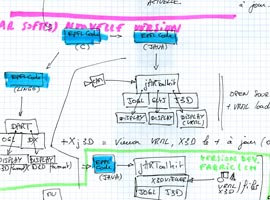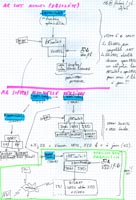« Loop.pH | Main | PATTERNS »
16. 07. 2005 17:31 | 03_Sketches_&_Projects_1 , 06_Comments , 12_Curated_posts
fabric | ch - technological input & links to our tools
Date: Fri, 15 Jul 2005 18:16:34 +0200
To: david.marimon@epfl.ch
From: Christian | Babski
Subject: Proposition - premières réflections
Cc: patrick keller
Hi David,
This last days, I had a look to existing tools on augmented reality (AR). It includes:
ARToolkit (version EPFL)
jARToolkit (java binding of ARToolkit via native code)
DART (pointed out by you)
About the tools you are using, it seems that your application is based on ARToolkit, on the top of which you have added your own functions for filtering and enhanced pattern tracking.
From this point of view, your work can be easily integrated to other pattern tracking systems like jARToolkit or DART in order to mix your results with these particular tools.
The main reason that pushes me to consider this option is that ARToolkit in its last version is a bit obsolete: it is based on libVRML, which has been developped/migrated to openVRML.
As we plan to enhance functionalities to 3D objects linked to tracked patterns, it implies that we should work and try to extend libVRML... extensions that can be considered as lost, as this library is not anymore up to date and is a bit abandonned by the community. Moreover, it seems that this library has some problems for compiling under .NET environment.
If we want to keep a more up to date version of the libVRML library, we will need to establish a link between ARToolkit and openVRML by compiling it under .NET (it seems possible with openVRML) or not (keep on working with VC++ 6.0 if needed). The main idea here is that extensions we can work on in the frame of this project can be useful and proposed as possible official extensions to openVRML: it makes possible to participate to an open source project during our collaboration. Moreover, the ARToolkit version linked to openVRML can be of some interests for the open source community (I do not think that this work was already made).
In the other hand, by considering jARToolkit and/or DART that both work correctly according to some tests I have made, it can bring us to consider the use of some other libraries for displaying AR final results. It can be possible to link with Xj3D viewer for example or use particular functionalities proposed by Director. Moreover, the use of JAVA (jARToolkit + Xj3D) or Director (DART) give us the ability to use some other tools we have already developped at fabric like our multi-user system rhizoreality. This tool can be integrated to Max/MSP, proposes functionalities like multiple view (CAVE-like system), collaborative work etc... it was used within several projects and exhibitions these last years.
So if my first impressions are corrects, your actual research results are developped above ARToolkit. It can be adapted to JAVA and/or Lingo in order to avoid being constrained by libVRML. It can allow us to take benefit of some other open source projects like Xj3D and it gives a chance for us to make a possible interesting contribution to them as well.
The link ARToolkit<->openVRML as well as code adaptation (to JAVA or Lingo) of your researches can be ensured on your side (by you or a student). Then, whatever the version of the final software will be used, the same research results can be shown. On our side, we can focus on the development of new tools (Xj3D+jARToolkit, rhizoreality, Max/MSP, etc...), both contributors taking advantage one from each other.
This reflection is just a set of proposals we can discuss about next week during a meeting. I do not made a precise evaluation of all technologies I have mentionned in this mail yet, so everything stays open for the moment.
Christian.
-


-
Download the scenario for AR Software development, a4 size (140k): View image
Posted by patrick keller at 16. 07. 2005 17:31
Comments
J'ajoute encore un deuxième commentaire lié aux fonctionnalités possibles. Il serait bien de pouvoir coupler le logiciel AR (tel que nous envisageons de le retravailler) avec des capacités de tracking vidéo basique. On pourra aisni cumuler un certains nombre de comportement par couple caméra/ordinateur.
Posted by: fabric | ch at 5. 09. 2005 18:45
J'ajoute aussi rapidement un élément qui n'est pas présent dans le message ou le schéma de Christian: le lien d'AR Toolkit ou JAR Toolkit, voir DART vers nos outils (tels que Rhizoreality.mu, système multi-users multi-clients) permettra également de faire le lien vers Max-Msp. Max-Msp nous ouvre toute sorte de possibilités d'intercations avec l'espace physique mais aussi avec l'espace des données. cela nous permettra d'associer la position de la caméra ou ce que la caméra regarde à différents type d'actions.
Patrick K.
Posted by: fabric | ch at 2. 08. 2005 14:07